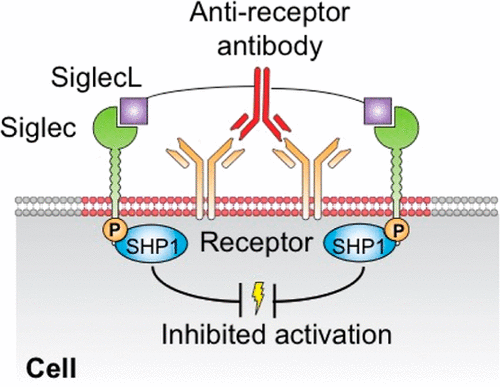当前位置:
X-MOL 学术
›
J. Am. Chem. Soc.
›
论文详情
Our official English website, www.x-mol.net, welcomes your
feedback! (Note: you will need to create a separate account there.)
Suppressing Immune Responses Using Siglec Ligand-Decorated Anti-receptor Antibodies
Journal of the American Chemical Society ( IF 14.4 ) Pub Date : 2022-05-20 , DOI: 10.1021/jacs.2c00922 Maidul Islam 1 , Britni M Arlian 1 , Fabian Pfrengle 1 , Shiteng Duan 1 , Scott A Smith 2 , James C Paulson 1
Journal of the American Chemical Society ( IF 14.4 ) Pub Date : 2022-05-20 , DOI: 10.1021/jacs.2c00922 Maidul Islam 1 , Britni M Arlian 1 , Fabian Pfrengle 1 , Shiteng Duan 1 , Scott A Smith 2 , James C Paulson 1
Affiliation

|
The sialic acid-binding immunoglobulin-type lectins (Siglecs) are expressed predominantly on white blood cells and participate in immune cell recognition of self. Most Siglecs contain cytoplasmic inhibitory immunoreceptor tyrosine-based inhibitory motifs characteristic of inhibitory checkpoint co-receptors that suppress cell signaling when they are recruited to the immunological synapse of an activating receptor. Antibodies to activatory receptors typically activate immune cells by ligating the receptors on the cell surface. Here, we report that the conjugation of high affinity ligands of Siglecs to antibodies targeting activatory immune receptors can suppress receptor-mediated activation of immune cells. Indeed, B-cell activation by antibodies to the B-cell receptor IgD is dramatically suppressed by conjugation of anti-IgD with high affinity ligands of a B-cell Siglec CD22/Siglec-2. Similarly, degranulation of mast cells induced by antibodies to IgE, which ligate the IgE/FcεR1 receptor complex, is suppressed by conjugation of anti-IgE to high affinity ligands of a mast cell Siglec, CD33/Siglec-3 (CD33L). Moreover, the anti-IgE-CD33L suppresses anti-IgE-mediated systemic anaphylaxis of sensitized humanized mice and prevents anaphylaxis upon subsequent challenge with anti-IgE. The results demonstrate that attachment of ligands of inhibitory Siglecs to anti-receptor antibodies can suppress the activation of immune cells and modulate unwanted immune responses.
中文翻译:

使用 Siglec 配体修饰的抗受体抗体抑制免疫反应
唾液酸结合免疫球蛋白型凝集素 (Siglecs) 主要在白细胞上表达,并参与免疫细胞对自身的识别。大多数 Siglec 包含抑制性检查点共受体的基于细胞质抑制性免疫受体酪氨酸的抑制性基序,当它们被募集到激活受体的免疫突触时抑制细胞信号传导。激活受体的抗体通常通过连接细胞表面的受体来激活免疫细胞。在这里,我们报告了 Siglecs 的高亲和力配体与靶向激活免疫受体的抗体的结合可以抑制受体介导的免疫细胞激活。的确,抗 IgD 与 B 细胞 Siglec CD22/Siglec-2 的高亲和力配体的结合显着抑制了 B 细胞受体 IgD 抗体对 B 细胞的激活。类似地,通过抗 IgE 与肥大细胞 Siglec、CD33/Siglec-3 (CD33L) 的高亲和力配体的缀合,抑制了由 IgE 抗体诱导的肥大细胞脱颗粒,该 IgE 抗体连接 IgE/FcεR1 受体复合物。此外,抗 IgE-CD33L 抑制抗 IgE 介导的致敏人源化小鼠的全身过敏反应,并防止随后用抗 IgE 激发的过敏反应。结果表明,抑制性 Siglecs 的配体与抗受体抗体的结合可以抑制免疫细胞的激活并调节不需要的免疫反应。抗 IgE 抗体诱导的肥大细胞脱颗粒,连接 IgE/FcεR1 受体复合物,通过抗 IgE 与肥大细胞 Siglec、CD33/Siglec-3 (CD33L) 的高亲和力配体的缀合来抑制。此外,抗 IgE-CD33L 抑制抗 IgE 介导的致敏人源化小鼠的全身过敏反应,并防止随后用抗 IgE 激发的过敏反应。结果表明,抑制性 Siglecs 的配体与抗受体抗体的结合可以抑制免疫细胞的激活并调节不需要的免疫反应。抗 IgE 抗体诱导的肥大细胞脱颗粒,连接 IgE/FcεR1 受体复合物,通过抗 IgE 与肥大细胞 Siglec、CD33/Siglec-3 (CD33L) 的高亲和力配体的缀合来抑制。此外,抗 IgE-CD33L 抑制抗 IgE 介导的致敏人源化小鼠的全身过敏反应,并防止随后用抗 IgE 激发的过敏反应。结果表明,抑制性 Siglecs 的配体与抗受体抗体的结合可以抑制免疫细胞的激活并调节不需要的免疫反应。抗 IgE-CD33L 抑制抗 IgE 介导的致敏人源化小鼠的全身性过敏反应,并防止随后用抗 IgE 激发的过敏反应。结果表明,抑制性 Siglecs 的配体与抗受体抗体的结合可以抑制免疫细胞的激活并调节不需要的免疫反应。抗 IgE-CD33L 抑制抗 IgE 介导的致敏人源化小鼠的全身性过敏反应,并防止随后用抗 IgE 激发的过敏反应。结果表明,抑制性 Siglecs 的配体与抗受体抗体的结合可以抑制免疫细胞的激活并调节不需要的免疫反应。
更新日期:2022-05-20
中文翻译:

使用 Siglec 配体修饰的抗受体抗体抑制免疫反应
唾液酸结合免疫球蛋白型凝集素 (Siglecs) 主要在白细胞上表达,并参与免疫细胞对自身的识别。大多数 Siglec 包含抑制性检查点共受体的基于细胞质抑制性免疫受体酪氨酸的抑制性基序,当它们被募集到激活受体的免疫突触时抑制细胞信号传导。激活受体的抗体通常通过连接细胞表面的受体来激活免疫细胞。在这里,我们报告了 Siglecs 的高亲和力配体与靶向激活免疫受体的抗体的结合可以抑制受体介导的免疫细胞激活。的确,抗 IgD 与 B 细胞 Siglec CD22/Siglec-2 的高亲和力配体的结合显着抑制了 B 细胞受体 IgD 抗体对 B 细胞的激活。类似地,通过抗 IgE 与肥大细胞 Siglec、CD33/Siglec-3 (CD33L) 的高亲和力配体的缀合,抑制了由 IgE 抗体诱导的肥大细胞脱颗粒,该 IgE 抗体连接 IgE/FcεR1 受体复合物。此外,抗 IgE-CD33L 抑制抗 IgE 介导的致敏人源化小鼠的全身过敏反应,并防止随后用抗 IgE 激发的过敏反应。结果表明,抑制性 Siglecs 的配体与抗受体抗体的结合可以抑制免疫细胞的激活并调节不需要的免疫反应。抗 IgE 抗体诱导的肥大细胞脱颗粒,连接 IgE/FcεR1 受体复合物,通过抗 IgE 与肥大细胞 Siglec、CD33/Siglec-3 (CD33L) 的高亲和力配体的缀合来抑制。此外,抗 IgE-CD33L 抑制抗 IgE 介导的致敏人源化小鼠的全身过敏反应,并防止随后用抗 IgE 激发的过敏反应。结果表明,抑制性 Siglecs 的配体与抗受体抗体的结合可以抑制免疫细胞的激活并调节不需要的免疫反应。抗 IgE 抗体诱导的肥大细胞脱颗粒,连接 IgE/FcεR1 受体复合物,通过抗 IgE 与肥大细胞 Siglec、CD33/Siglec-3 (CD33L) 的高亲和力配体的缀合来抑制。此外,抗 IgE-CD33L 抑制抗 IgE 介导的致敏人源化小鼠的全身过敏反应,并防止随后用抗 IgE 激发的过敏反应。结果表明,抑制性 Siglecs 的配体与抗受体抗体的结合可以抑制免疫细胞的激活并调节不需要的免疫反应。抗 IgE-CD33L 抑制抗 IgE 介导的致敏人源化小鼠的全身性过敏反应,并防止随后用抗 IgE 激发的过敏反应。结果表明,抑制性 Siglecs 的配体与抗受体抗体的结合可以抑制免疫细胞的激活并调节不需要的免疫反应。抗 IgE-CD33L 抑制抗 IgE 介导的致敏人源化小鼠的全身性过敏反应,并防止随后用抗 IgE 激发的过敏反应。结果表明,抑制性 Siglecs 的配体与抗受体抗体的结合可以抑制免疫细胞的激活并调节不需要的免疫反应。













































 京公网安备 11010802027423号
京公网安备 11010802027423号